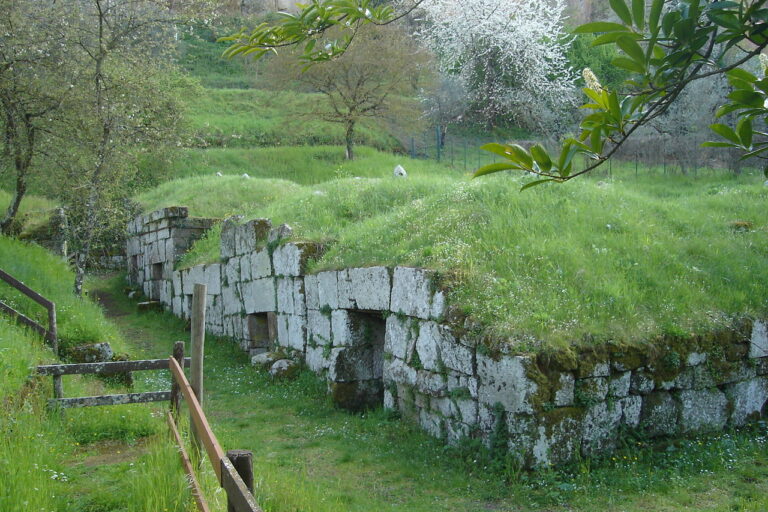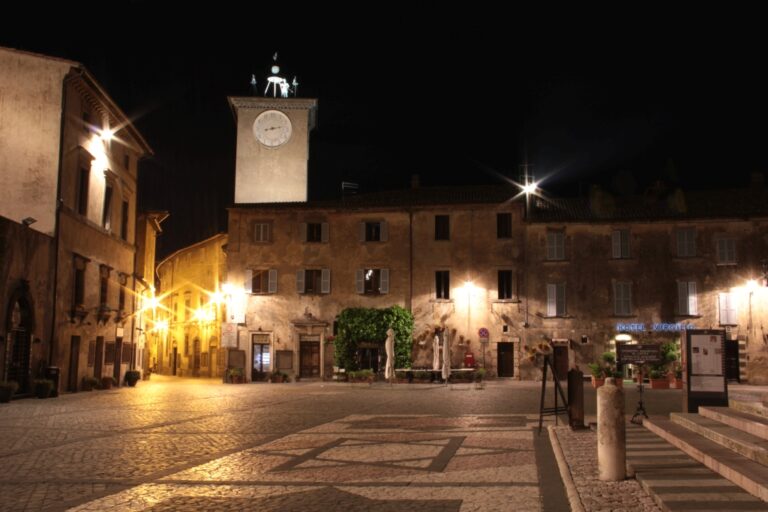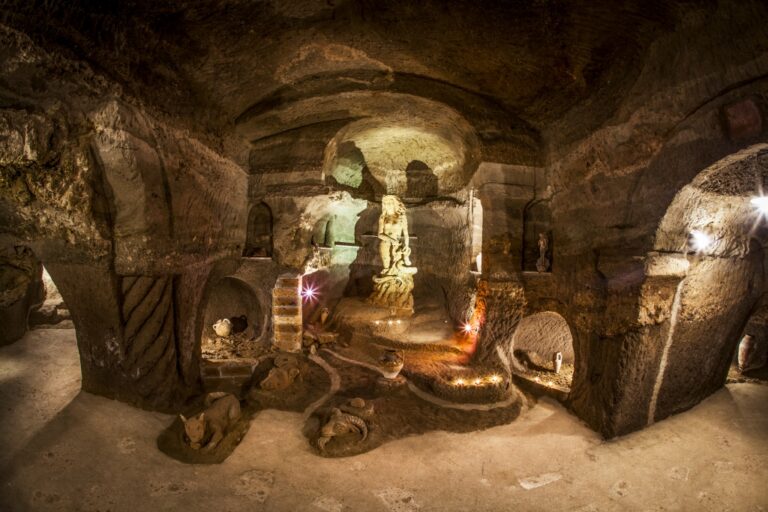Orvieto, in the center of Italy, built in a hilly area on the top of tufa rocks – the so-called Rupe is a majestic and fascinating city. In just over a kilometer in length and over eight hundred meters in width, the city boasts artistic and cultural testimonies from the Etruscan era to our second millennium.
Orvieto
As for the museum circuits, do not miss the National Archaeological Museum of the Superintendence for Archaeological Heritage of Umbria, the Archaeological Museum “Claudio Faina”, the MODO, or the museum circuit of the Opera del Duomo, the Orvieto Underground underground circuit. .
Moreover Orvieto offers the visitor its pleasant atmosphere of a quiet city but socially and culturally lively. There are many cultural events of greater or lesser importance throughout the year: from Umbria Jazz Winter, every year between Christmas and the new year, to the long cultural festival of Venti Ascensionali from October to February, to the theatrical season of the Mancinelli Theater which hosts concerts, debates, numerous conferences and book presentations which, almost incessantly, enliven the city.
The commercial offer is also interesting, where, in addition to some elegant boutiques, the eno-gastronomic offer and craftsmanship are distinguished, represented by some workshops of goldsmith art, woodworking, leather, terracotta, ceramics and of the precious Orvieto lace.
Orvieto is part of the Cittaslow international association, an organization that brings together many cities around the world under the banner of “slow living”, characterized by urban planning on a human scale, a rich civil and cultural fabric, attention to quality of life of the inhabitants, a strong protection of food and wine traditions.
The Etruscan splendor, whose peak can be placed between the sixth and fourth centuries BC, was followed by a period of decline and exile. In fact, in 264 A.D. the Romans annihilated the city and forced its inhabitants to take refuge in present-day Bolsena, called Volsinii Novi: in what had been the glorious Etruscan city nothing but abandonment and ruins reigned. Orvieto was thus consigned, for some centuries, to the oblivion of history.
After the barbarian invasions, in which it was conquered by the Goths and the Lombards, the city returned to occupy a strategic importance because it was placed on the border line of Byzantine Italy.
It was in the Middle Ages that the current urban layout was imposed, the typical conformation of a medieval city that still today characterizes much of the historic center. In 1175, Pope Adrian IV recognized the autonomy of the city and Orvieto became a free municipality. Palaces, towers and churches were built and, starting from 1290, the year in which the first stone was laid, the marvelous Duomo. Between the thirteenth and fourteenth centuries, with its 30,000 inhabitants, the population even exceeded that of Rome. Often at war with Siena, Viterbo, Todi and Perugia, Orvieto reached its maximum power around 1300, managing to appropriate Orbetello and Talamone on the Tyrrhenian Sea. The power of the free Commune, however, was undermined by the internal war between the Guelph part of the Monaldeschi family and the Ghibelline part of the Filippeschi. The continuous conflicts weakened the political and military power, so that in 1364 Cardinal Egidio Albornoz, encountering only little resistance, did not have to struggle too much in making the city his own.
After being elevated to the seat of the Apostolic Delegation in 1831, Orvieto was annexed to the Kingdom of Italy in 1860.
Three centuries were necessary to finish the Cathedral of Orvieto, built, according to a tradition however contradicted by official documents, to celebrate the miracle of the Eucharist, which took place in Bolsena in 1263 and the subsequent institution of the feast of Corpus Domini. The Cathedral of Orvieto was not created to house the precious relic: two popes (Alexander VIII in 1658 and John Paul II) have in fact denied the alleged and direct link between miracle and building. For centuries, however, the traditional link between the Duomo and the Miracle of Bolsena continued to survive in the town’s devotion, also shared by historians and scholars such as Luigi Fumi. Pope John Paul II tried to clarify this “legend” by stating, in the homily delivered by the Cathedral of Orvieto on 17 June 1990, the day of Corpus Domini, that: “even if the construction of the Cathedral is not directly connected to the solemnity of Corpus Domini, established by Pope Urban IV with the Bull Transiturus in 1264, nor to the miracle that took place in Bolsena the previous year, however, there is no doubt that the Eucharistic mystery is powerfully evoked here by the corporal of Bolsena, for which the chapel was specially built. who now jealously guards it ”.
The link between Orvieto and wine can well be defined as ancentral. It seems that in ancient times the tuff city was called Oinarea, that is the “city where the wine flows”, mentioned by the pseudo-Aristotle in a treatise in which the Etruscan customs in terms of drinks, and pleasures.
The fundamental role of wine in daily life and in the cult ceremonies of ancient Orvieto is attested in the important paintings of the Etruscan tombs in the area (second half of the 4th century BC). From the Orvieto necropolis there are also valuable manufactures of Etruscan buccheri and ceramics imported from Greece in order to contain the wine, finds that clearly and further testify the importance that the Etruscans gave to this drink. The Etruscans used to put wine in the caves of the Orvieto cliff, as is still used today, gradually moving it to different heights to bring it to maturity.
In ancient Etruria, wine was never tasted in its pure state, but mixed with other liquids and flavored with spices. In the magnificent rooms of the Faina Museum, for example, it is possible to admire refined typology of ollae and amphoras, vessels intended to contain wine on the occasion of aristocratic ceremonies or rituals; painted stamnoi and krateres, useful, just before tasting, to oxygenate, cut and mix wine; oinokoai with which it was easily poured into kylikes and kantharoi, painted or decorated goblets in cylinders or molds, according to the imagination of the potters and the taste of the clients.
Today, the area of white Orvieto D.O.C. it covers the mostly hilly areas of Orvieto and Orvieto. It is among the most representative of Umbrian wines and covers 70% of the D.O.C market in the province of Terni. It is obtained from a combination of Procanico (variant of the Tuscan Trebbiano), Verdello, Drupeggio, Grechetto and Malvasia. It is distinguished in Orvieto and Orvieto Classico, based on the area of origin, and may have a “superior” type depending on the application of a specification that criteria certain parameters of production. Orvieto can be dry, sweet and sweet.
There is also a variety of Rosso Orvietano, sometimes full-bodied and suitable for game. The care in the production of red Orvieto led to the recognition, in 1998, of two D.O.C. For the Rosso Orvietano D.O.C. the basic vines of Corbara, Cabernet franc, Canaiolo, Montepulciano, Ciliegiolo are used, while among the complementary ones, Colorino and Dolcetto are used.
End of december
Stagione teatrale al “Teatro Mancinelli”
Opera and shows from October to May
Easter concert in Duomo
During the Easter period
Festa della Palombella
Domenica di Pentecoste
Corpus Domini
Historic parade
Corteo delle Dame
Medieval dinner
More information
Servizio Turistico Associato dell’Orvietano
Piazza Duomo 24 – Orvieto
Tel. +39 0763 341772 – +39 0763 341911 – +39 0763 343658
Tourist information office
Piazza Duomo 24 – Telephone: +39 0763.341772
E-mail: info.iat@comune.orvieto.tr.it















